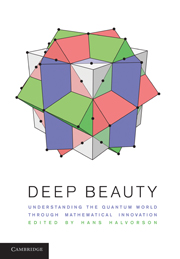Book contents
- Frontmatter
- Contents
- Contributors
- Preface
- Acknowledgments
- Introduction
- I Beyond the Hilbert Space Formalism: Category Theory
- 1 A Prehistory of n-Categorical Physics
- 2 A Universe of Processes and Some of Its Guises
- 3 Topos Methods in the Foundations of Physics
- 4 The Physical Interpretation of Daseinisation
- 5 Classical and Quantum Observables
- 6 Bohrification
- II Beyond the Hilbert Space Formalism: Operator Algebras
- III Behind the Hilbert Space Formalism
- Index
2 - A Universe of Processes and Some of Its Guises
from I - Beyond the Hilbert Space Formalism: Category Theory
Published online by Cambridge University Press: 01 June 2011
- Frontmatter
- Contents
- Contributors
- Preface
- Acknowledgments
- Introduction
- I Beyond the Hilbert Space Formalism: Category Theory
- 1 A Prehistory of n-Categorical Physics
- 2 A Universe of Processes and Some of Its Guises
- 3 Topos Methods in the Foundations of Physics
- 4 The Physical Interpretation of Daseinisation
- 5 Classical and Quantum Observables
- 6 Bohrification
- II Beyond the Hilbert Space Formalism: Operator Algebras
- III Behind the Hilbert Space Formalism
- Index
Summary
Introduction
Our starting point is a particular “canvas” aimed to “draw” theories of physics, which has symmetric monoidal categories as its mathematical backbone. In this chapter, we consider the conceptual foundations for this canvas and how these can then be converted into mathematical structure.
With very little structural effort (i.e., in very abstract terms) and in a very short time span, the categorical quantum mechanics (CQM) research program, initiated by Abramsky and this author, has reproduced a surprisingly large fragment of quantum theory [3, 45, 48, 56, 60–62, 170, 179]. It also provides new insights both in quantum foundations and in quantum information—for example, in [49–51, 58, 59, 64, 79, 80]—and has even resulted in automated reasoning software called quantomatic [71–73], which exploits the deductive power of CQM, which is indeed a categorical quantum logic [77].
In this chapter, we complement the available material by not requiring prior knowledge of category theory and by pointing at connections to previous and current developments in the foundations of physics.
This research program is also in close synergy with developments elsewhere—for example, in representation theory [74], quantum algebra [176], knot theory [187], topological quantum field theory (TQFT) [132], and several other areas.
- Type
- Chapter
- Information
- Deep BeautyUnderstanding the Quantum World through Mathematical Innovation, pp. 129 - 186Publisher: Cambridge University PressPrint publication year: 2011
- 5
- Cited by



